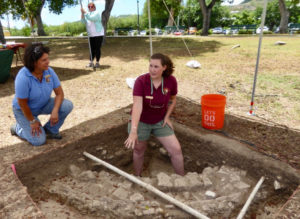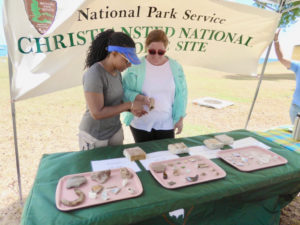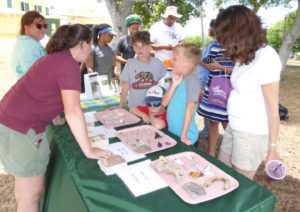“The streets of Rome are filled with rubble. Ancient footprints run everywhere.” – When I Paint My Masterpiece, by Bob Dylan.

History books focus on the rich and powerful and it can be difficult to find information about how working people lived, especially those from underrepresented communities – and even more so, the lives of enslaved people in places like St. Croix.
But the ground of St. Croix tells that story, to those who look and listen.
National Park Service archaeologist Meredith Hardy and technician Amelia Jansen shared some of the most recent finds at the Christiansted National Historic Site at an open house last week.
The event was part of the Slave Wrecks Project. Later the same day in Frederiksted there was a spirited talk about the history and community of Free Gut, connected to the Free Gut Archaeology Project.
Hardy said the Slave Wrecks Project and the archaeological work sponsored by the University of the Virgin Islands and other groups is to “help not just uncover the history of slavery, the history from slavery to freedom here on St. Croix, but also to provide opportunities to train local youth, local high school and college kids about cultural heritage management, about how to do archaeology, find the artifacts, discover the sites. how to interpret those sites, how to preserve the artifacts, and then how to tell that story to the world.”
One unusual feature they’ve been excavating for the last couple of weeks is still a bit of a mystery.

“Alright, so we’ve got a round structure that is built with Danish yellow bricks and large rocks,” Jansen said. “We have hit a plaster floor that is both on the outside and on the inside, a little bit lower, so we can see that it was holding water. Underneath the plaster floor we’ve got clay. So we know that that is the bottom of our basin structure. So eventually we would like to be able to open up the entire thing and be able to get a better idea of what this feature actually was in the area and what it was being used for,” she said.
It might have been a utilitarian area for holding water, perhaps for watering livestock or washing clothes. As the NPS is able to receive grants, the progress of unearthing this part of Crucian history will continue.
Some of the artifacts uncovered in the excavations were laid out on a table for visitors to see.
“Most of them date from the late 1700s, early 1800s. It’s really neat,” Hardy said.
“We have what’s called transfer print ware, which we know began being made in England and across Europe around 1775-1780. And we can tell how old it is based on coloring that pools in here. So we know this is around 1785, 1790,” she said, holding up a shard with a blue and white design on one side, while pointing to yellow stains on the back.
“We have got pipe stems. We’ve got really neat marbles, glass marbles and clay marbles. And marbles weren’t really used only by children. They were actually used by soldiers, they were used by adults to help them with gambling and also just to pass the time,” Hardy said.

There are bones, bone buttons and remains of food; bones that were sawed and cut and hacked and cooked right there on site, she said.
“And we have some of the pottery that was used to actually cook, and some of this pottery was made in Europe and some of it was made right here on St. Croix by enslaved Africans,” she said, holding up a large pot with soot marks from sitting over a fire. “We can do special tests on the inside of this to see what kinds of fats, what kinds of foods were being cooked in here and we can identify what kinds of meals they were making. So science is cool!” she said.
Hardy said the project works with students from the University of the Virgin Islands and local high schools.
“We have been very lucky to have one intern who has worked with us for several years. Ms. Tiara Decosta,” she said. Hardy said Decosta is currently on the mainland with a group called the Greening Youth Foundation. Students get internships all around the country and get special training to help them prepare for careers in resource management.
In the late afternoon, the Free Gut Archaeology Project gave a presentation and afterward there was a vocal discussion. The Free Gut Archaeology Project, is community based, headed by the group CHANT (Crucian History And Nature Tourism). The principal investigator is Gabrielle Miller, a doctoral student from University of Tulsa, who is working under the guidance of Alicia Odewale. It is considered a community arts project to call public attention to marginalized populations.
Its research goals are:
– Connecting enslaved, free and self emancipated narratives.
– Redefining resistance and place making.
– Examining and filling in the void of material on underrepresented communities.
– Impacting and involving marginalized and underrepresented communities.
Monica Marin, the Invisible Heritage Project Curator, said the overall goals of the project are to bring together art and design, vocational training, mentorship and community revitalization.
After a slideshow presentation, those in attendance broke into two groups to discuss how this project could go forward and what people felt was important. Several people were very vocal about getting oral histories of “the real people of Frederiksted,” and of the very poor.This group felt that having their stories told going back in time was essential.
These two events are only some of the recent archeological and historical discussions on St. Croix in recent weeks. Earlier events are described here and here.






The marbles found are more than likely inserts placed in bottles to keep carbonation in. The children broke the bottles to get the marbles to play with